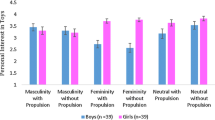Abstract
The physical movement and social characteristics of effeminate behavior-problem, referred boys (N=13)were compared with those of normal boys (N=25)and boys (N=12)referred for nongender problems. Parent reports, observer ratings, and videotapes were collected in a series of structured tasks. As expected, mothers described gender-problem sons as much more feminine than the other two groups in interests, activities, and mannerisms. Gender-problem sons were also seen as relatively inactive and introverted. Further, they were non-significantly lower than the clinical control boys in perceived behavior problems, but both groups had marginally more problems than the normal boys. Gender-problem and clinical control boys both showed more body constriction than normal boys in ratings of a videotaped interview. They also both showed less ideal ball-throw form than normal boys on a set of variables scored with slow-motion video. However, in a set of behaviors directly rated in the various tasks, the gender-problem boys gave a uniquely general impression of uncoordination. The groups did not differ on seven additional variables.
Similar content being viewed by others
Reference notes
Bates, J. E.A brief review of child effects research. Symposium paper presented at the Midwestern Psychological Association Convention, Chicago, 1977.
Klein, A. R., & Bates, J. E.Gender-typing of game choices and qualities of boys' play behavior. Unpublished manuscript, Indiana University.
Thompson, S. K., Bates, J. E., & Bentler, P. M.Testing assumptions of gender identification by comparing gender problem and normal groups of boys and their parents. Paper presented to the Society for Research in Child Development, New Orleans, 1977.
Rekers, G. A., Bentler, P. M., & Rosen, A. C.Congruence of childhood sex-role identity and behavior disturbances. Under editorial review.
References
Acosta, F. X. Etiology and treatment of homosexuality: A review.Archives of Sexual Behavior, 1975,4, 9–29.
Bakwin, H. Deviant gender-role behavior in children: Relation to homosexuality.Pediatrics, 1968,41, 620–629.
Bates, J. E., Bentler, P. M., & Thompson, S. Measurement of deviant gender development in boys.Child Development, 1973,44, 591–598.
Bates, J. E., Skilbeck, W. M., Smith, K. V. R., & Bentler, P. M. Gender role abnormalities in boys: An analysis of clinical ratings.Journal of Abnormal Child Psychology, 1974,2, 1–16.
Bentler, P. M. A typology of transsexualism: Gender identity theory and data.Archives of Sexual Behavior, 1976,5, 567–584.
Campbell, D. T., & Fiske, D. W. Convergent and discriminant validation by the multitraitmultimethod matrix.Psychological Bulletin, 1959,56, 81–105.
Endler, M. S., & Magnusson, D. (Eds.).Interactional psychology and personality. New York: Halsted, 1976.
Fagot, B. Consequences of moderate cross-gender behavior in preschool children.Child Development, 1977,48, 902–907.
Green, R.Sexual identity conflict in children and adults. New York: Basic Books, 1974.
Love, L. R., & Kaswan, J. W.Troubled children: Their families, schools, and treatments. New York: Wiley, 1974.
Mehrabian, A.Nonverbal communication. Chicago: Aldine, 1972.
Quay, H. C. Patterns of aggression, withdrawal, and immaturity. In H. C. Quay, & J. S. Werry (Eds.),Psychopathological disorders of childhood. New York: Wiley, 1972.
Rekers, G. A. Assessment and treatment of childhood gender problems. In B. B. Lahey & A. E. Kazdin (Eds.),Advances in clinical child psychology (Vol. 1). New York: Plenum, 1977.
Rekers, G. A., Bentlet, P. M., Rosen, A. C., & Lovaas, O. I. Child gender disturbances: A clinical rationale for intervention.Psychotherapy: Theory, Research and Practice, 1977,14, 2–11.
Rekers, G. A., Crandall, B. F., Rosen, A. C., & Bentler, P. M. Genetic and physical studies of male children with psychological gender disturbances.Psychological Medicine, 1979, in press.
Rekers, G. A., Rosen, A. C., Lovaas, O. I., & Bentler, P. M. Sex-role stereotypy and professional intervention for childhood gender disturbance.Professional Psychology, 1978,9, 127–136.
Rosen, A. C., Rekers, G. A., & Bentler, P. M. Ethical issues in the treatment of children.Journal of Social Issues, 1978,34, 122–136.
Skilbeck, W. M., Bates, J. E., & Bentler, P. M. Human figure drawings of gender-problem and school-problem boys.Journal of Abnormal Child Psychology, 1975,3, 191–199.
Wickstrom, R. L.Fundamental motor patterns (2nd ed.). Philadelphia: Lea & Febiger, 1977.
Zuger, B. Gender role determination: A critical review of the evidence from hermaphroditism.Psychosomatic Medicine, 1970,32, 449–468.
Zuger, B., & Taylor, P. Effeminate behavior present in boys from early childhood II: Comparison with similar symptoms in non-effeminate boys.Pediatrics, 1969,44, 375–380.
Author information
Authors and Affiliations
Additional information
The research was supported in part by USPHS Grant MH17072. The authors are indebted to the more than two dozen research staff members who contributed many essential services at various stages of the project, to the families who generously participated, to the clinicians who referred their clients to our project, and to Marion Hee for computational assistance.
Rights and permissions
About this article
Cite this article
Bates, J.E., Bentler, P.M. & Thompson, S.K. Gender-deviant boys compared with normal and clinical control boys. J Abnorm Child Psychol 7, 243–259 (1979). https://doi.org/10.1007/BF00916535
Revised:
Issue Date:
DOI: https://doi.org/10.1007/BF00916535




